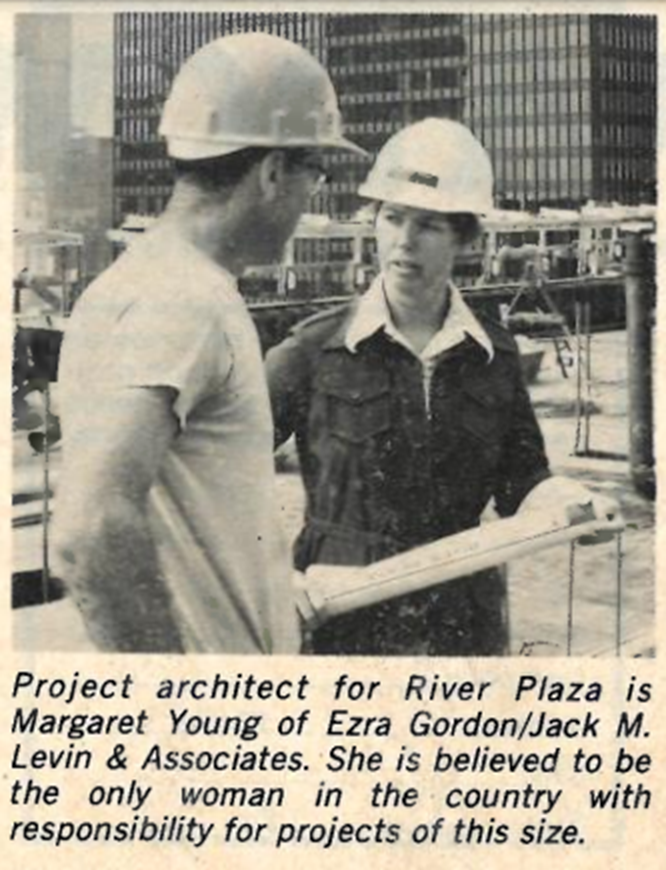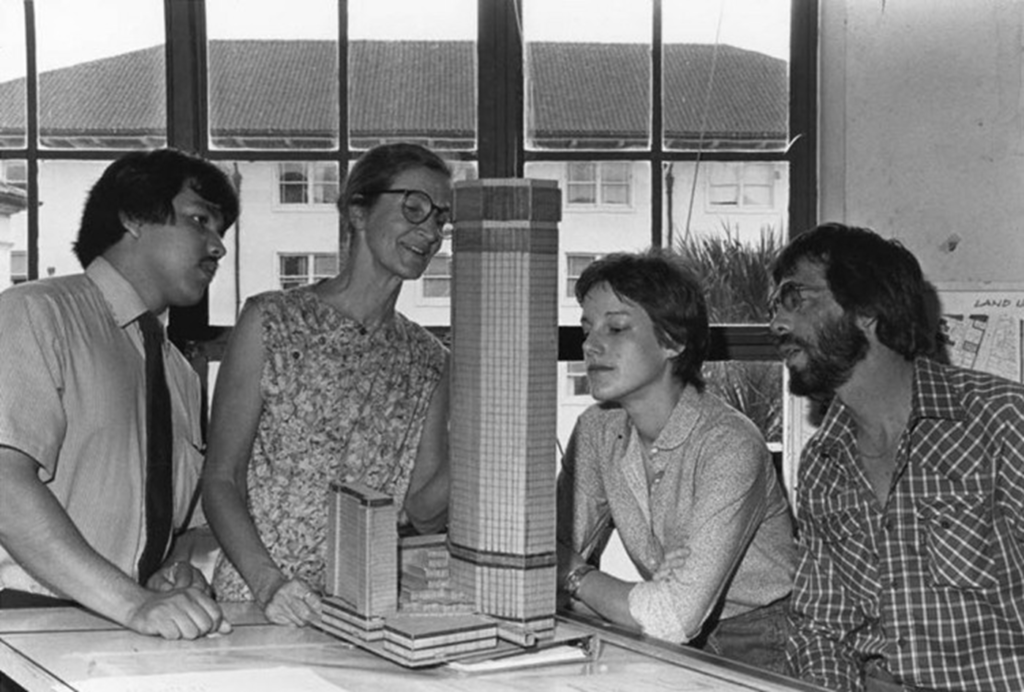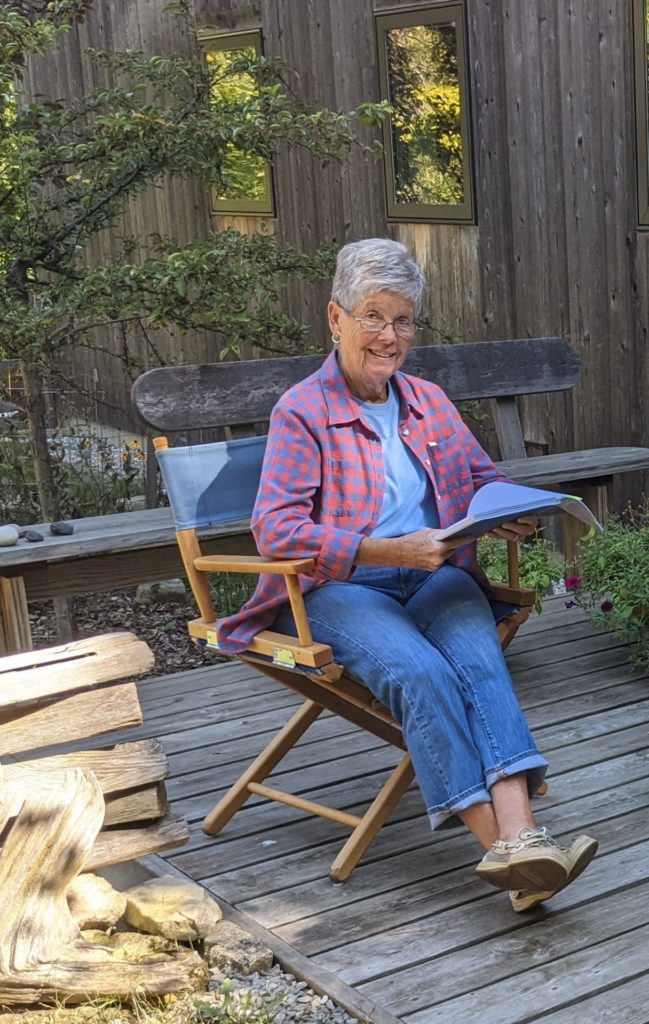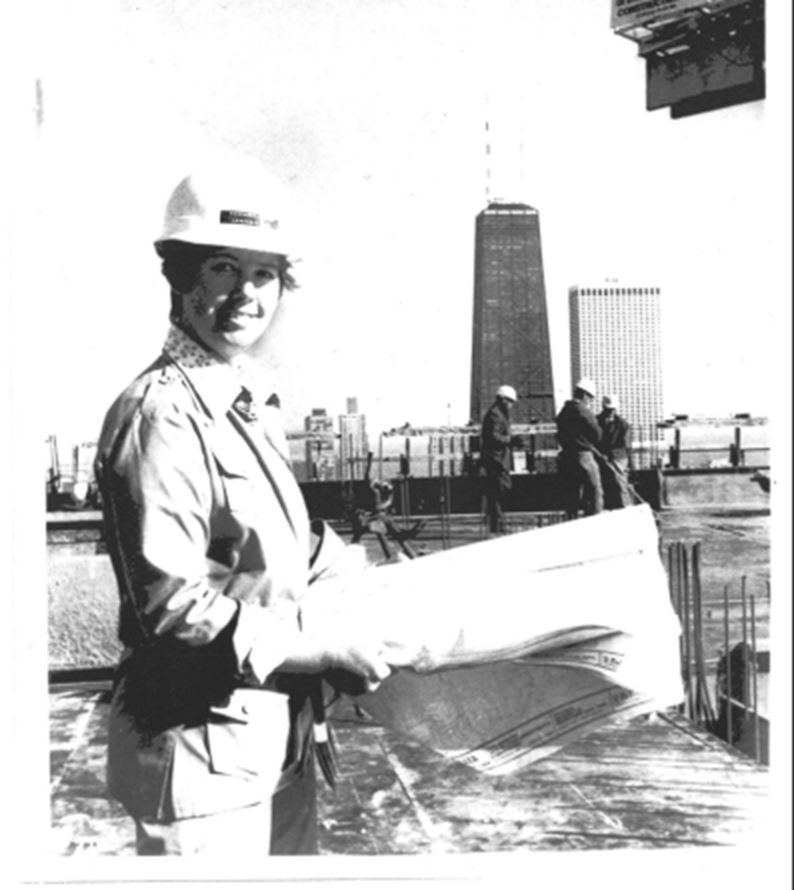November 5, 2021
(This is an extended version of an article that first appeared in our November 2021 edition of The Arch newsletter.)
Earlier this year, Landmarks Illinois launched Women Who Built Illinois: a first-of-its-kind database that includes information on female architects, engineers, developers, designers, builders, landscape architects, interior designers and their clients and their projects in Illinois between 1879 and 1979.
Among the many women highlighted in the new database is Margaret Zirkel Young. Young became a licensed architect in Illinois in 1971 and had a long, successful career working at firms like Ezra Gordon & Jack M. Levin & Associates where she served as project architect on iconic Chicago skyscrapers like Newberry Plaza, built in 1974, and River Plaza, built in 1977. Young was a founding member of Chicago Women in Architecture and later became a registered real estate broker. She retired in 2002.
Below, Young shares insights on her unique career and experiences working in the male-dominated architecture field.
LANDMARKS ILLINOIS: WHAT WAS YOUR MOST CHALLENGING AND REWARDING PROJECT WHILE AT EZRA GORDON & JACK M. LEVIN & ASSOCIATES FROM 1969 TO 1986? WERE ANY CLIENTS RELUCTANT TO WORK WITH YOU SINCE YOU WERE A WOMAN?
MARGARET ZIRKEL YOUNG: As a young architect, when assigned to actually monitor the Newberry Plaza project construction from excavation and foundations to the roof top, that was probably my biggest challenge. I knew I could do it and I had my employers’ total confidence. Of course, I was a little concerned about how I might be received and accepted, but I was not totally alone out there. There were other design representatives (like structural and mechanical/electrical engineers) who monitored their part of the project and with whom I already had a very good rapport from earlier months of coordinating our construction documents. It was more than gratifying to quickly gain the respect of the construction crews. Yes, many tested me, but I always had the answers or made a quick decision to solve their perceived problem. I actually had the pleasure to work with many of them again on future projects.

(Young at River Plaza from Building Design and Construction, 1976.)
It was also a challenge to gain the acceptance and respect of our clients, especially the construction superintendents and foremen on project sites. Luckily, that never took very long. Only recently, after reading Ezra Gordon’s oral history, did I learn of one of our biggest client/contractors voicing a very strong objection to my presence on the Newberry Plaza construction site, specifically noting there was no toilet for a woman to use. I, however, learned quickly to scout out the closest coffee shop or local restaurant for available public toilet facilities at a new project site.
LI: ARE THERE ANY WOMEN IN THE ARCHITECTURE PROFESSION WHO INSPIRED YOU OR WHO YOU VIEWED AS A MENTOR?
MZY: In the 1970s, I met Natalie Griffin de Blois, a true star, very experienced, successful and gracious lady. She was 20 years my senior, and I came to respect her in many ways. Natalie freely shared her experiences as a woman in a large, well-known international firm (Skidmore, Owings & Merrill). I definitely viewed her as a mentor and good friend.

(Architect Natalie Griffin de Blois (second from left), who Young said was a mentor and friend, teaching at the University of Texas. Courtesy of the University of Texas. Learn more about DeBlois at the Landmarks Illinois’ Women Who Built Illinois database.)
LI: You teamed with other female architects to create a Triton College-sponsored video “Shadows on the Landscape,” which won an AIA Illinois award in 1977, to stimulate interest in architecture for high school students. Who developed the concept for the video and is it still available?
MZY: I recall that a common point of discussion for many of us women was the lack of exposure and knowledge of career possibilities in architecture. Alyce Knight, a Triton College architecture teacher, and I decided to do something about that, and were soon joined by Betty Ritter, a writer and publisher, and Celia Pew, an urban planner. I was the practicing architect with access to offices, construction sites and other filming sites. We four met for weeks and jointly developed a script of exactly what we wanted to say and what needed to be visually shown.
I remember filming in Harry Weese’s office and convincing Joe Karr, the landscape architect, to agree to be interviewed by me for his services on a pretend project as the camera rolled. It was a huge project for us to take on while having full time jobs, but it also was an extremely rewarding experience for us four. The 34-minute color videotape (available in video cassette or film format) was highly used for several years. Unfortunately, and for reasons unknown to me, it has not been available for many years now. Of course by now, the profession and it’s processes have greatly changed and the film would be somewhat outdated.
LI: You retired to Washington Island, Wisconsin, after a long career in architecture and real estate and have enjoyed painting for many years. What did you like most about the architect profession?
MZY: My career in architecture was not typical. It was long (1966-2002) and much more varied than I expect other women experienced. That variety is what I enjoyed most about my profession. When I retired, I finally had time to begin other interests like serious birding, painting and photographing the nature around us. I continue to find great enjoyment in these and other new activities.

(Young in 2021. Courtesy of Margaret Zirkel Young.)
LI: WHAT ADVICE WOULD YOU HAVE FOR WOMEN PURSUING A CAREER IN ARCHITECTURE?
MZY: Before you make that decision, make a list of what you think you will be doing and then go and see practicing architects’ offices and talk to them about their current and past projects, their philosophies and what makes them return to work each day.
Don’t be naïve, be realistic. Understand that you more than likely will never change the world of architecture and create a new style or trend. Recognize that a career as an architect, and especially as a woman, can still be very lonely and competitive.
Get a good understanding or experience of the construction field ASAP. Get your hands and shoes dirty and experience how things get built. If nothing else, start by getting permission to watch the various processes at a construction site near you and ask a lot of questions. You may decide that interior architecture or an engineering focus might be a better choice to pursue.
As an architect, be creative but also be ready to bend your design sights and be ready to accept change to meet and not exceed each client’s budget. Be smart, tough but fair, persevering, secure in making the right decisions and 100 percent dedicated to your profession and you will surely succeed and enjoy the journey as I did.
Above all, be willing to work hard (true of most professional careers) and for less financial rewards than you might envision.
(Top photo: Young on the top deck of Newberry Plaza, 1972.)

